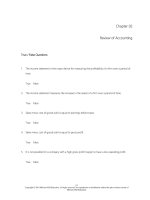Excel modeling in corporate finance 5th global edtion by holden
Bạn đang xem bản rút gọn của tài liệu. Xem và tải ngay bản đầy đủ của tài liệu tại đây (18.19 MB, 230 trang )
Global
Edition
Excel Modeling
in Corporate Finance
FiFth Edition
Craig W. holden
EXCEL® MODELING IN CORPORATE FINANCE
Fifth Edition
Global Edition
CRAIG W. HOLDEN
Professor of Finance
Kelley School of Business
Indiana University
Boston Columbus Indianapolis New York San Francisco Upper Saddle River
Amsterdam Cape Town Dubai London Madrid Milan Munich Paris Montreal Toronto
Delhi Mexico City Sao Paulo Sydney Hong Kong Seoul Singapore Taipei Tokyo
To Kathryn, Diana, and Jimmy.
Editorial Project Manager: Erin McDonagh
Head of Learning Asset Acquisition, Global
Edition: Laura Dent
Editorial Assistant: Elissa Senra-Sargent
Managing Editor: Jeff Holcomb
Acquisitions Editor, Global Edition: Steven Jackson
Associate Project Editor, Global Edition: Binita Roy
Production Project Manager: Karen Carter
Operations Specialist: Carol Melville
Cover Image: © Kurt Kleemann / Shutterstock
Cover designer: Lumina Datamtics
Credits and acknowledgments borrowed from other sources and reproduced, with permission, in this textbook appear on the
appropriate page within text.
Microsoft and/or its respective suppliers make no representations about the suitability of the information contained in the
documents and related graphics published as part of the services for any purpose. All such documents and related graphics are
provided "as is" without warranty of any kind. Microsoft and/or its respective suppliers hereby disclaim all warranties and
conditions with regard to this information, including all warranties and conditions of merchantability, whether express, implied or
statutory, fitness for a particular purpose, title and non-infringement. In no event shall Microsoft and/or its respective suppliers be
liable for any special, indirect or consequential damages or any damages whatsoever resulting from loss of use, data or profits,
whether in an action of contract, negligence or other tortious action, arising out of or in connection with the use or performance
of information available from the services.
The documents and related graphics contained herein could include technical inaccuracies or typographical errors. Changes
are periodically added to the information herein. Microsoft and/or its respective suppliers may make improvements and/or
changes in the product(s) and/or the program(s) described herein at any time. Partial screen shots may be viewed in full within
the software version specified.
Microsoft® and Windows® are registered trademarks of the Microsoft Corporation in the U.S.A. and other countries. This book
is not sponsored or endorsed by or affiliated with the Microsoft Corporation.
Pearson Education Limited, Edinburgh Gate, Harlow, Essex CM20 2JE, England
and Associated Companies throughout the world
Visit us on the World Wide Web at: www.pearsonglobaleditions.com
© Pearson Education Limited 2015
The rights of Craig W. Holden to be identified as the author of this work have been asserted by him in accordance with the
Copyright, Designs and Patents Act 1988.
Authorized adaptation from the United States edition, entitled Excel Modeling in Corporate Finance, 5th edition, ISBN 978-0205-98725-2, by Craig W. Holden, published by Pearson Education © 2015.
All rights reserved. No part of this publication may be reproduced, stored in a retrieval system, or transmitted in any form or by
any means, electronic, mechanical, photocopying, recording or otherwise, without either the prior written permission of the
publisher or a license permitting restricted copying in the United Kingdom issued by the Copyright Licensing Agency Ltd,
Saffron House, 6–10 Kirby Street, London EC1N 8TS.
All trademarks used herein are the property of their respective owners. The use of any trademark in this text does not vest in the
author or publisher any trademark ownership rights in such trademarks, nor does the use of such trademarks imply any affiliation
with or endorsement of this book by such owners.
ISBN 10: 1-292-05938-9
ISBN 13: 978-1-292-05938-9 (Print)
ISBN 13: 978-1-292-07149-7 (PDF)
British Library Cataloguing-in-Publication Data
A catalogue record for this book is available from the British Library
14 13 12 11 10 9 8 7 6 5 4 3 2 1
Typeset in 10.8 Times New Roman by Cypress Graphics.
Printed and bound in Great Britain by Clays Ltd, Bungay, Suffolk.
Contents 3
CONTENTS
Preface ........................................................................................8
Fifth Edition Changes ........................................................................................ 8
Ready-To-Build Spreadsheets ........................................................................... 8
What is Unique about This Book .................................................................... 11
Conventions Used in This Book....................................................................... 12
Craig’s Challenge ............................................................................................. 14
ExcelTM Modeling Books .................................................................................. 14
Suggestions for Faculty Members ................................................................... 14
Acknowledgments ............................................................................................. 15
About The Author ...................................................................17
PART 1 TIME VALUE OF MONEY .... 18
Chapter 1 Single Cash Flow ...................................................18
1.1 Present Value .............................................................................................. 18
1.2 Future Value ............................................................................................... 19
Problems ............................................................................................................ 20
Chapter 2 Annuity ..................................................................21
2.1 Present Value .............................................................................................. 21
2.2 Future Value ............................................................................................... 22
2.3 System of Four Annuity Variables ............................................................ 23
Problems ............................................................................................................ 24
Chapter 3 NPV Using Constant Discounting .......................25
3.1 Nominal Rate .............................................................................................. 25
3.2 Real Rate ..................................................................................................... 26
Problems ............................................................................................................ 27
Chapter 4 NPV Using General Discounting .........................28
4.1 Nominal Rate .............................................................................................. 28
4.2 Real Rate ..................................................................................................... 30
Problems ............................................................................................................ 32
Chapter 5 Loan Amortization ...............................................33
5.1 Basics ........................................................................................................... 33
5.2 Sensitivity Analysis ..................................................................................... 34
Problems ............................................................................................................ 36
Chapter 6 Lease Vs. Buy ........................................................37
6.1 Car ............................................................................................................... 37
6.2 Corporate .................................................................................................... 37
Problems ............................................................................................................ 39
PART 2 VALUATION ............................ 40
Chapter 7 Bond Valuation .....................................................40
7.1 Annual Payments ........................................................................................ 40
7.2 EAR, APR, and Foreign Currencies ......................................................... 41
7.3 Duration and Convexity ............................................................................. 46
4 Contents
7.4 Price Sensitivity .......................................................................................... 48
7.5 System of Five Bond Variables .................................................................. 50
Problems ............................................................................................................ 51
Chapter 8 Estimating the Cost of Capital ............................54
8.1 Static CAPM Using Fama-MacBeth Method ........................................... 54
8.2 APT or Intertemporal CAPM Using Fama-McBeth Method ................. 58
Problems ............................................................................................................ 63
Chapter 9 Stock Valuation .....................................................64
9.1 Dividend Discount Model ........................................................................... 64
Problems ............................................................................................................ 65
Chapter 10 Firm and Project Valuation ...............................66
10.1 Cash Flows for Five Equivalent Methods ............................................... 66
10.2 Adjusted Present Value ............................................................................ 69
10.3 Free Cash Flow To Equity ....................................................................... 70
10.4 Free Cash Flow to the Firm ..................................................................... 71
10.5 Dividend Discount Model ......................................................................... 72
10.6 Residual Income........................................................................................ 73
10.7 Five Equivalent Methods ......................................................................... 74
Problems ............................................................................................................ 83
Appendix: Reconciling the Residual Income Method with Other
Approaches to Valuing Firms or Projects ...................................................... 84
Chapter 11 The Yield Curve ..................................................90
11.1 Obtaining It From Treasury Bills and Strips ......................................... 90
11.2 Using It To Price A Coupon Bond........................................................... 91
11.3 Using It To Determine Forward Rates ................................................... 92
Problems ............................................................................................................ 93
Chapter 12 US Yield Curve Dynamics .................................94
12.1 Dynamic Chart.......................................................................................... 94
Problems ............................................................................................................ 99
PART 3 CAPITAL STRUCTURE....... 101
Chapter 13 Capital Structure ..............................................101
13.1 Modigliani-Miller With No Taxes ......................................................... 101
13.2 Modigliani-Miller With Corporate Taxes ............................................ 103
13.3 Trade-off Model: Tax Shield vs. Distress Cost..................................... 105
Problems .......................................................................................................... 107
PART 4 CAPITAL BUDGETING ....... 108
Chapter 14 Project NPV .......................................................108
14.1 Basics ....................................................................................................... 108
14.2 Forecasting Cash Flows.......................................................................... 111
14.3 Working Capital ..................................................................................... 112
14.4 Sensitivity Analysis ................................................................................. 114
Problems .......................................................................................................... 117
Chapter 15 Cost-Reducing Project .....................................118
15.1 Basics ....................................................................................................... 118
15.2 Sensitivity Analysis ................................................................................. 121
Problems .......................................................................................................... 122
Contents 5
Chapter 16 Break-Even Analysis ........................................123
16.1 Based On Accounting Profit .................................................................. 123
16.2 Based On NPV ........................................................................................ 126
Problems .......................................................................................................... 130
PART 5 FINANCIAL PLANNING ..... 131
Chapter 17 Corporate Financial Planning .........................131
17.1 Actual....................................................................................................... 131
17.2 Forecast ................................................................................................... 134
17.3 Cash Flow ................................................................................................ 138
17.4 Ratios ....................................................................................................... 140
17.5 Sensitivity ................................................................................................ 142
17.6 Full-Scale Estimation ............................................................................. 143
Problems .......................................................................................................... 149
Chapter 18 Du Pont System Of Ratio Analysis..................152
18.1 Basics ....................................................................................................... 152
Problems .......................................................................................................... 153
Chapter 19 Life-Cycle Financial Planning .........................154
19.1 Taxable Vs. Traditional Vs. Roth Savings............................................ 154
19.2 Basic Life-Cycle Planning ...................................................................... 156
19.3 Full-Scale Life-Cycle Planning .............................................................. 158
Problems .......................................................................................................... 165
PART 6 INTERNATIONAL
CORPORATE FINANCE .................... 166
Chapter 20 International Parity ..........................................166
20.1 System of Four Parity Conditions ......................................................... 166
20.2 Estimating Future Exchange Rates ....................................................... 168
Problems .......................................................................................................... 169
PART 7 OPTIONS AND CORPORATE
FINANCE ............................................... 170
Chapter 21 Binomial Option Pricing ..................................170
21.1 Estimating Volatility .............................................................................. 170
21.2 Single Period ........................................................................................... 171
21.3 Multi-Period ............................................................................................ 174
21.4 Risk Neutral ............................................................................................ 178
21.5 Average of N and N-1 ............................................................................. 181
21.6 Convergence to Normal.......................................................................... 183
21.7 American With Discrete Dividends ....................................................... 185
21.8 Full-Scale ................................................................................................. 189
Problems .......................................................................................................... 194
Chapter 22 Real Options ......................................................196
22.1 Option To Abandon ................................................................................ 196
22.2 Option to Expand ................................................................................... 197
6 Contents
22.3 Option to Contract ................................................................................. 198
22.4 Option To Choose ................................................................................... 199
22.5 Compound Option .................................................................................. 201
Problems .......................................................................................................... 204
Chapter 23 Black-Scholes Option Pricing ..........................206
23.1 Basics ....................................................................................................... 206
23.2 Continuous Dividend .............................................................................. 207
23.3 Implied Volatility .................................................................................... 211
Problems .......................................................................................................... 213
Chapter 24 Debt And Equity Valuation .............................215
24.1 Two Methods........................................................................................... 215
24.2 Impact of Risk ......................................................................................... 217
Problems .......................................................................................................... 218
PART 8 EXCEL SKILLS ..................... 219
Chapter 25 Useful Excel Tricks ...........................................219
25.1 Quickly Delete The Instructions and Arrows....................................... 219
25.2 Freeze Panes ............................................................................................ 219
25.3 Spin Buttons and the Developer Tab .................................................... 220
25.4 Option Buttons and Group Boxes ......................................................... 221
25.5 Scroll Bar................................................................................................. 223
25.6 Install Solver or the Analysis ToolPak.................................................. 224
25.7 Format Painter........................................................................................ 224
25.8 Conditional Formatting ......................................................................... 225
25.9 Fill Handle ............................................................................................... 226
25.10 2-D Scatter Chart ................................................................................. 226
25.11 3-D Surface Chart................................................................................. 228
DOWNLOADABLE CONTENTS
Excel Modeling in Corporate Finance Fifth Edition.pdf
Ready-To-Build spreadsheets available in both XLSX
and XLS file formats:
Ch 01 Single Cash Flow - Ready-To-Build.xlsx
Ch 02 Annuity - Ready-To-Build.xlsx
Ch 03 NPV Using Constant Discounting - Ready-To-Build.xlsx
Ch 04 NPV Using General Discounting - Ready-To-Build.xlsx
Ch 05 Loan Amortization - Ready-To-Build.xlsx
Ch 06 Lease Vs Buy - Ready-To-Build.xlsx
Ch 07 Bond Valuation - Ready-To-Build.xlsx
Ch 08 Estimating the Cost of Capital - Ready-To-Build.xlsx
Ch 09 Stock Valuation - Ready-To-Build.xlsx
Ch 10 Firm and Project Valuation - Ready-To-Build.xlsx
Ch 11 The Yield Curve - Ready-To-Build.xlsx
Ch 12 US Yield Curve Dynamics - Ready-To-Build.xlsx
Ch 13 Capital Structure - Ready-To-Build.xlsx
Ch 14 Project NPV - Ready-To-Build.xlsx
Ch 15 Cost-Reducing Project - Ready-To-Build.xlsx
Contents 7
Ch 16 Break-Even Analysis - Ready-To-Build.xlsx
Ch 17 Corporate Financial Planning - Ready-To-Build.xlsx
Ch 18 Du Pont System of Ratio Analysis - Ready-To-Build.xlsx
Ch 19 Life-Cycle Financial Planning - Ready-To-Build.xlsx
Ch 20 International Parity - Ready-To-Build.xlsx
Ch 21 Binomial Option Pricing - Ready-To-Build.xlsx
Ch 22 Real Options - Ready-To-Build.xlsx
Ch 23 Black-Scholes Option Pricing - Ready-To-Build.xlsx
Ch 24 Debt and Equity Valuation - Ready-To-Build.xlsx
8 Preface
Preface
For more than 30 years, since the emergence of Lotus 1-2-3 and Microsoft
ExcelTM in the 1980s, spreadsheet models have been the dominant vehicles for
finance professionals in the business world to implement their financial
knowledge. Yet even today, most Corporate Finance textbooks have very limited
coverage of how to build Excel models. This book fills that gap. It teaches
students how to build financial models in Excel. It provides step-by-step
instructions so that students can build models themselves (active learning), rather
than being handed already-completed spreadsheets (passive learning). It
progresses from simple examples to practical, real-world applications. It spans
nearly all quantitative models in corporate finance, including nearly all niche
areas of corporate finance.
My goal is simply to change finance education from limited treatment of the most
basic Excel models to comprehensive treatment of both simple and sophisticated
Excel models. This change will better prepare students for their future business
careers. It will increase student evaluations of teacher performance by enabling
more practical, real-world content and by allowing a more hands-on, active
learning pedagogy.
Fifth Edition Changes
The Fifth Edition adds great new corporate finance content:
•
•
•
Real options, including project valuation with abandonment options,
expansion options, contraction options, chooser options, and compound
options
Lease vs. buy decisions, including car and corporate applications
Taxable vs. traditional vs. Roth savings plans
All of the real-world data, including financial statements, bond prices, the yield
curve, asset returns, exchange rates, and options prices, have been updated.
Ready-To-Build Spreadsheets
This product includes Ready-To-Build spreadsheets, which can be downloaded
from www.pearsonglobaleditions.com/Holden. The spreadsheets are available in
both “XLSX” and “XLS” file formats. By default, the screen shots and
instructions in the book are based on Excel 2013. For the items explained in this
book, there are no significant differences relative to Excel 2010. There are few
places where there are differences relative to Excel 2007. In those instances
“Excel 2007 Equivalent” boxes have been added in the margin to explain how to
do the equivalent step in Excel 2007.
Preface 9
The instruction boxes on the Ready-To-Build spreadsheets are bitmapped images
so that the formulas cannot just be copied to the spreadsheet. Both the instruction
boxes and arrows are objects, so that they can easily be deleted when the
spreadsheet is complete. Just select the boxes and arrows and press delete. This
leaves a clean spreadsheet for future use.
Ready-To-Build Spreadsheets for every chapter provide:
A model setup, such as input values,
labels, and graphs
Step-by-step instructions for building the
model on the spreadsheet itself
All instructions
are explained
twice: once in
English and a
second time as
an Excel
formula
Students enter
the formulas
and copy them
as instructed
to build the
spreadsheet
10 Preface
Spin buttons, option buttons, and graphs facilitate visual, interactive learning
Preface 11
Many spreadsheets
use real-world data
What is Unique about This Book
There are many features which distinguish this book from any other:
•
Plain Vanilla Excel. Other books on the market emphasize teaching students
programming using Visual Basic for Applications (VBA) or using macros.
By contrast, this book does nearly everything in plain vanilla Excel.
Although programming is liked by a minority of students, it is seriously
disliked by the majority. Excel has the advantage of being a very intuitive,
user-friendly environment that is comprehensible to all. It is fully capable of
handling a wide range of applications, including quite sophisticated ones.
Further, the only assumption is that your students already know the basics of
Excel, such as entering formulas in a cell and copying formulas from one cell
to another. All other features of Excel (such as built-in functions, Data
Tables, Solver, etc.) are explained as they are used.
•
Build from Simple Examples to Practical, Real-World Applications. The
general approach is to start with a simple example and build up to a practical,
12 Preface
real-world application. In many chapters, the previous Excel model is carried
forward to the next, more complex model. For example, the chapter on
binomial option pricing carries forward Excel models as follows: (a.) singleperiod model with replicating portfolio, (b.) eight-period model with
replicating portfolio, (c.) eight-period model with risk-neutral probabilities,
(d.) eight-period model with risk-neutral probabilities for American or
European options with discrete dividends, (e.) full-scale, fifty-period model
with risk-neutral probabilities for American or European options with
discrete dividends. Whenever possible, this book builds up to full-scale,
practical applications using real data. Students are excited to learn practical
applications that they can actually use in their future jobs. Employers are
excited to hire students with Excel modeling skills, who can be more quickly
productive.
•
Supplement for All Popular Corporate Finance Textbooks. This book is a
supplement to be combined with a primary textbook. This means that you
can keep using whatever textbook you like best. You don’t have to switch. It
also means that you can take an incremental approach to incorporating Excel
modeling. You can start modestly and build up from there.
•
A Change in Content, Too. Excel modeling is not merely a new medium,
but an opportunity to cover some unique content items which require
computer support to be feasible. For example, the full-scale estimation Excel
model in Corporate Financial Planning uses three years of historical 10K data
on Nike, Inc. (including every line of their income statement, balance sheet,
and cash flow statement), constructs a complete financial system (including
linked financial ratios), and projects these financial statements three years
into the future. The chapter on Estimating the Cost of Capital uses 10 years
of monthly returns for individual stocks, U.S. Fama-French portfolios, and
country ETFs to estimate the cost of capital using the Static CAPM based on
the Fama-MacBeth method and to estimate the cost of capital using the APT
or Intertemporal CAPM based on the Fama-MacBeth method. The Excel
model to estimate firm valuation or project valuation demonstrates the
equivalence of the Free Cash Flow To Equity, Free Cash Flow to the Firm,
Residual Income, Dividend Discount Model, and the Adjusted Present Value
technique, not just in the perpetuity case covered by some textbooks, but for
a fully general two-stage project with an arbitrary set of cash flows over an
explicit forecast horizon, followed by an infinite horizon growing perpetuity.
As a practical matter, all of these sophisticated applications require Excel.
Conventions Used in This Book
This book uses a number of conventions.
•
Time Goes Across the Columns and Variables Go Down the Rows. When
something happens over time, I let each column represent a period of time.
For example, in life-cycle financial planning, date 0 is in column B, date 1 is
in column C, date 2 is in column D, etc. Each row represents a different
Preface 13
variable, which is usually labeled in column A. This manner of organizing
Excel models is common because it is how financial statements are
organized.
•
Color Coding. A standard color scheme is used to clarify the structure of the
Excel models. The Ready-To-Build spreadsheets available for download use:
(1) yellow shading for input values, (2) no shading (i.e. white) for throughput
formulas, and (3) green shading for final results (“the bottom line”). A few
Excel models include choice variables with blue shading.
•
The Timeline Technique. The most natural technique for discounting cash
flows in an Excel model is the timeline technique, where each column
corresponds to a period of time. As an example, see the section labeled
“Bond Price using a Timeline” in the figure below.
•
Using as Many Different Techniques as Possible. In the figure above, the
bond price is calculated using as many different techniques as possible.
Specifically, it is calculated three ways: (1) discounting each cash flow on a
time line, (2) using the closed-form formula, and (3) using Excel’s PV
function. This approach makes the point that all three techniques are
equivalent. This approach also develops skill at double-checking these
calculations, which is a very important method for avoiding errors in
practice.
14 Preface
•
Symbolic Notation is Self-Contained. Every spreadsheet that contains
symbolic notation in the instruction boxes is self-contained (i.e., all symbolic
notation is defined on the spreadsheet).
Craig’s Challenge
I challenge the reader of this book to dramatically improve your finance
education by personally constructing all of the Excel models in this book. This
will take you about 10–20 hours depending on your current Excel modeling
skills. Let me assure you that it will be an excellent investment. You will:
•
•
•
gain a practical understanding of the core concepts of Corporate Finance
develop hands-on, Excel modeling skills
build an entire suite of finance applications, which you fully understand
When you complete this challenge, I invite you to e-mail me at
to share the good news. Please tell me your name, school,
(prospective) graduation year, and which Excel modeling book you completed. I
will add you to a web-based honor roll at:
/>We can celebrate together!
ExcelTM Modeling Books
This book is one of two Excel Modeling books by Craig W. Holden, published by
Pearson. The other book is Excel Modeling in Investments. Both books teach
value-added skills in constructing financial models in Excel. Complete
information about my Excel Modeling books is available at my web site:
If you have any suggestions or corrections, please e-mail them to me at
I will consider your suggestions and will implement any
corrections in the next edition.
Suggestions for Faculty Members
There is no single best way to use Excel Modeling in Corporate Finance. There
are as many different techniques as there are different styles and philosophies of
teaching. You need to discover what works best for you. Let me highlight several
possibilities:
1. Out-of-class individual projects with help. This is a technique that I have
used and it works well. I require completion of several short Excel modeling
Preface 15
projects of every individual student in the class. To provide help, I schedule
special “help lab” sessions in a computer lab during which time I and my
graduate assistant are available to answer questions while students do each
assignment in about an hour. Typically about half the questions are Excel
questions and half are finance questions. I have always graded such projects,
but an alternative approach would be to treat them as ungraded homework.
2. Out-of-class individual projects without help. Another technique is to
assign Excel modeling projects for individual students to do on their own out
of class. One instructor assigns seven Excel modeling projects at the
beginning of the semester and has individual students turn in all seven
completed Excel models for grading at the end of the semester. At the end of
each chapter are problems that can be assigned with or without help. Faculty
members can download the completed Excel models and answers to end-ofchapter problems at See
your local Pearson representative to gain access.
3. Out-of-class group projects. A technique that I have used for the last fifteen
years is to require students to do big Excel modeling projects in groups. I
have students write a report to a hypothetical boss that intuitively explains
their method of analysis, key assumptions, and key results.
4. In-class reinforcement of key concepts. The class session is scheduled in a
computer lab or students are asked to bring their laptop computers to class. I
explain a key concept in words and equations. Then I turn to a 10–15 minute
segment in which students open a Ready-To-Build spreadsheet and build the
Excel model in real-time in the class. This provides real-time, hands-on
reinforcement of a key concept. This technique can be done often throughout
the semester.
5. In-class demonstration of Excel modeling. The instructor can perform an
in-class demonstration of how to build Excel models. Typically, only a small
portion of the total Excel model would be demonstrated.
6. In-class demonstration of key relationships using Spin Buttons, Option
Buttons, and Charts. The instructor can dynamically illustrate comparative
statics or dynamic properties over time using visual, interactive elements. For
example, one spreadsheet provides a “movie” of 43 years of U.S. term
structure dynamics. Another spreadsheet provides an interactive graph of the
sensitivity of bond prices to changes in the coupon rate, yield-to-maturity,
number of payments/year, and face value.
I’m sure I haven’t exhausted the list of potential teaching techniques. Feel free to
send an e-mail to to let me know novel ways in which
you use this book.
Acknowledgments
I thank Katie Rowland, Tessa O’Brien, Mark Pfaltzgraff, David Alexander,
Jackie Aaron, P.J. Boardman, Mickey Cox, Maureen Riopelle, and Paul Donnelly
16 Preface
of Pearson for their vision, innovativeness, and encouragement of Excel
Modeling in Corporate Finance. I thank Erin McDonagh, Karen Carter, Amy
Foley, Nancy Fenton, Susan Abraham, Mary Kate Murray, Ana Jankowski, Lori
Braumberger, Holly Brown, Debbie Clare, Cheryl Clayton, Kevin Hancock, Josh
McClary, Bill Minic, Melanie Olsen, Beth Ann Romph, Erika Rusnak, Gladys
Soto, and Lauren Tarino of Pearson / Prentice Hall for many useful contributions.
I thank Robert Taggart of Boston College for his significant contribution to the
Firm and Project Valuation chapter and for his appendix to that chapter on
“Reconciling the Residual Income Method with Other Approaches to Valuing
Firms or Projects.” I thank Professors Alan Bailey (University of Texas at San
Antonio), Zvi Bodie (Boston University), Jack Francis (Baruch College), David
Griswold (Boston University), Carl Hudson (Auburn University), Robert
Kleiman (Oakland University), Mindy Nitkin (Simmons College), Steve Rich
(Baylor University), Tim Smaby (Penn State University), Noah Stoffman
(Indiana University), Charles Trzcinka (Indiana University), Sorin Tuluca
(Fairleigh Dickinson University), Marilyn Wiley (Florida Atlantic University),
and Chad Zutter (University of Pittsburgh) for many thoughtful comments. I
thank my dad, Bill Holden, and my graduate students Michael Kulov, Sam
Singhania, Harry Bramson, Brent Cherry, Scott Marolf, Heath Eckert, Ryan
Brewer, Ruslan Goyenko, Wendy Liu, and Wannie Park for careful errorchecking. I thank Jim Finnegan and many other students for providing helpful
comments. I thank my family, Kathryn, Diana, and Jimmy, for their love and
support.
Pearson wishes to thank and acknowledge Nadeem Aftab (Abu Dhabi
University) for his work on the Global Edition.
Preface 17
About The Author
CRAIG W. HOLDEN
Craig W. Holden is a Professor of Finance at the
Kelley School of Business at Indiana University.
His M.B.A. and Ph.D. are from the Anderson
School at UCLA. He is the winner of many
teaching and research awards, including a
Fama/DFA Prize. His research on market
microstructure has been published in leading
academic journals. He has written Excel
Modeling in Investments and Excel Modeling
in Corporate Finance. The Fifth Editions in
English are published by Pearson and there are
International, Chinese, and Italian editions. He
has chaired 20 dissertations, been a member or
chair of 58 dissertations, serves as the
Secretary-Treasurer of the Society for Financial Studies, serves as an
associate editor of the Journal of Financial Markets, and serves on the
program committees of the Western Finance Association and the
European Finance Association. He chaired the department undergraduate
committee for thirteen years, chaired the department doctoral committee for four
years, chaired three different schoolwide committees for a combination of six
years, and currently serves for a third year on the campus tenure advisory
committee. He has led several major curriculum innovations in the finance
department. More information is available at Craig’s home page:
www.kelley.iu.edu/cholden.
18 PART 1 Time Value of Money
PART 1 TIME VALUE OF MONEY
Chapter 1 Single Cash Flow
1.1 Present Value
Problem. A single cash flow of $1,000.00 will be received in 5 periods. For this
cash flow, the appropriate discount rate / period is 6.0%. What is the present
value of this single cash flow?
Solution Strategy. We will calculate the present value of this single cash flow in
three equivalent ways. First, we will calculate the present value using a time line,
where each column corresponds to a period of calendar time. Second, we use a
formula for the present value. Third, we use Excel’s PV function for the present
value.
Excel 2013
FIGURE 1.1 Excel Model for Single Cash Flow - Present Value.
CHAPTER 1 Single Cash Flow 19
The Present Value of this Single Cash Flow is $747.26. Notice you get the same
answer all three ways: using the time line, using the formula, or using the PV
function!
1.2 Future Value
Problem. A single cash flow of $747.26 is available now (in period 0). For this
cash flow, the appropriate discount rate / period is 6.0%. What is the period 5
future value of this single cash flow?
Solution Strategy. We will calculate the future value of the single cash flow in
three equivalent ways. First, we will calculate the future value using a time line,
where each column corresponds to a period of calendar time. Second, we use a
formula for the future value. Third, we use Excel’s FV function for the future
value.
Excel 2013
FIGURE 1.2 Excel Model for Single Cash Flow - Future Value.
The Future Value of this Single Cash Flow is $1,000.00. Notice you get the same
answer all three ways: using the time line, using the formula, or using the FV
function!
20 PART 1 Time Value of Money
Comparing Present Value and Future Value, we see that they are opposite
operations. That is, one operation "undoes" the other. The Present Value of
$1,000.00 in period 5 is $747.26 in period 0. The Future Value of $747.26 in
period 0 is $1,000.00 in period 5.
Problems
1. A single cash flow of $1,723.48 will be received in 6 periods. For this cash
flow, the appropriate discount rate / period is 6.8%. What is the present value
of this single cash flow?
2. A single cash flow of $1,032.47 is available now (in period 0). For this cash
flow, the appropriate discount rate / period is 2.9%. What is the period 5
future value of this single cash flow?
CHAPTER 2 Annuity 21
Chapter 2 Annuity
2.1 Present Value
Problem. An annuity pays $80.00 each period for 5 periods. For these cash
flows, the appropriate discount rate / period is 6.0%. What is the present value of
this annuity?
Solution Strategy. We will calculate the present value of this annuity in three
equivalent ways. First, we will calculate the present value using a time line,
where each column corresponds to a period of calendar time. Second, we use a
formula for the present value. Third, we use Excel’s PV function for the present
value.
Excel 2013
FIGURE 2.1 Excel Model for Annuity - Present Value.
The Present Value of this Annuity is $336.99. Notice you get the same answer all
three ways: using the time line, using the formula, or using the PV function.
22 PART 1 Time Value of Money
2.2 Future Value
Problem. An annuity pays $80.00 each period for 5 periods. For these cash
flows, the appropriate discount rate / period is 6.0%. What is the period 5 future
value of this annuity?
Solution Strategy. We will calculate the future value of this annuity in three
equivalent ways. First, we will calculate the future value using a time line, where
each column corresponds to a period of calendar time. Second, we use a formula
for the future value. Third, we use Excel’s FV function for the future value.
Excel 2013
FIGURE 2.2 Excel Model for Annuity - Future Value.
The Future Value of this Annuity is $450.97. Notice you get the same answer all
three ways: using the time line, using the formula, or using the FV function.
CHAPTER 2 Annuity 23
2.3 System of Four Annuity Variables
Problem. There is a tight connection between all of the inputs and output to
annuity valuation. Indeed, they form a system of four annuity variables: (1)
Payment, (2) Discount Rate / Period, (3) Number of Periods, and (4) Present
Value. Given any three of these variables, find the fourth variable.
Solution Strategy. Given any three of these variable, we will use as many
equivalent ways of solving for the fourth variable as possible. The Annuity –
Present Value spreadsheet solves for the present value using a Timeline, a
formula, and the PV function. Building on that spreadsheet, add the Payment
using the formula and PMT function. Then add the Discount Rate / Period using
the RATE function. Then add the Number of Periods, using the NPER function.
Excel 2013
FIGURE 2.3 Excel Model for Annuity - System of Four Annuity Variables.
24 PART 1 Time Value of Money
We see that the system of four annuity variables is internally consistent. The four
outputs in rows 13 through 32 (Present Value = $336.99, Payment = $80.00,
Discount Rate / Period = 6.0%, and Number of Periods = 5) are identical to the
four inputs in rows 4 through 7. Thus, any of the four annuity variables can be
calculated from the other three in a fully consistent manner.
Problems
1) An annuity pays $132.38 each period for 5 periods. For these cash flows, the
appropriate discount rate / period is 3.5%. What is the present value of this
annuity?
2) An annuity pays $63.92 each period for 4 periods. For these cash flows, the
appropriate discount rate / period is 9.1%. What is the period 5 future value
of this annuity?
3) Consider a system of four annuity variables.
(a) An annuity pays $63.00 each period for 3 periods. For these cash flows,
the appropriate discount rate / period is 8.0%. What is the present value
of this annuity?
(b) An annuity pays each period for 11 periods, the appropriate discount rate
/ period is 6.0%, and the present value is $192.38. What is the payment
each period?
(c) An annuity pays $183.00 each period for 14 periods, and the present
value is $463.94. What is the discount rate / period of this annuity?
(d) An annuity pays $30.00 each period, the appropriate discount rate /
period is 7.6%, and the present value is $218.49. What is the number of
periods?









